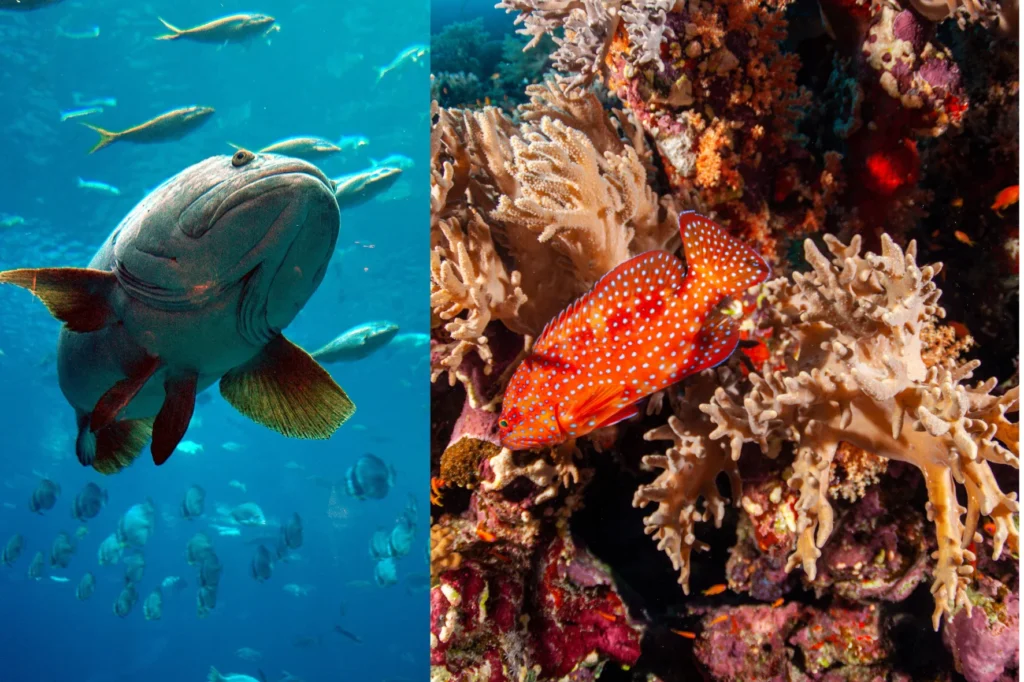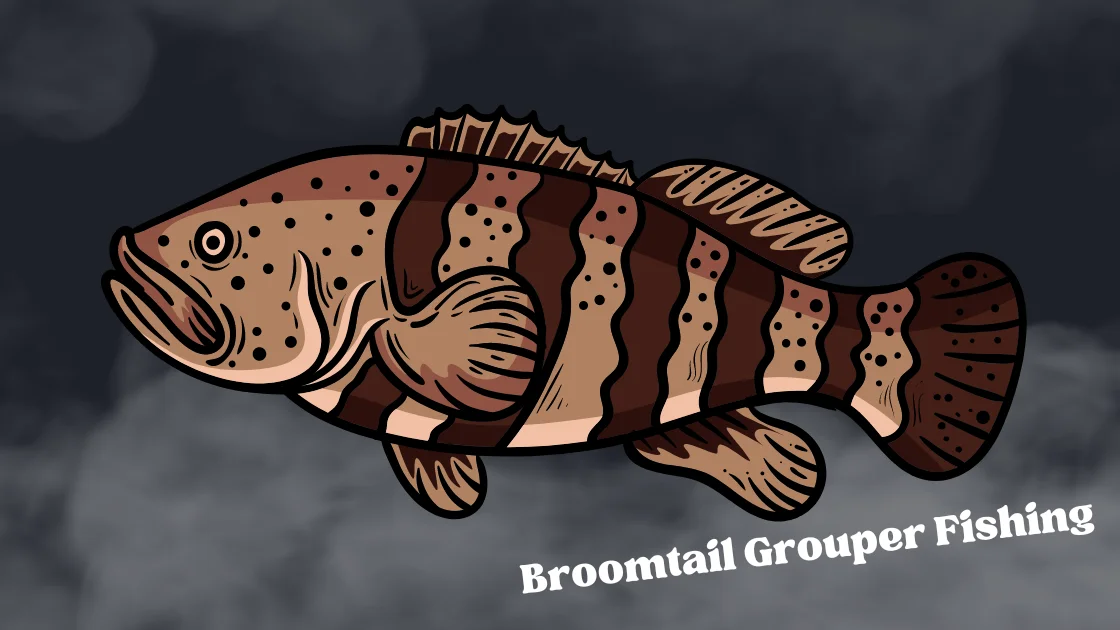As an avid angler, one of the most thrilling experiences I’ve had is Broomtail Grouper fishing. The Broomtail Grouper, scientifically known as “Mycteroperca xenarcha,” is a prized catch for many fishing enthusiasts due to its impressive size and fighting spirit. In this article, I will share with you the secrets to successful Broomtail Grouper fishing, including understanding their behavior and habitat, the best fishing techniques, essential gear and equipment, effective bait and lures, safety precautions, and the best fishing spots for this magnificent species.
Behavior and Habitat of Broomtail Grouper
To increase your chances of a successful Broomtail Grouper fishing trip, it is crucial to understand their behavior and habitat. Broomtail Groupers are found in the warm waters of the Pacific Ocean, particularly along the coasts of Mexico and Central America. They prefer rocky reefs and structures such as underwater caves and ledges, where they can hide and ambush their prey. These groupers are known to be solitary creatures, often found in depths ranging from 60 to 300 feet.
During the day, Broomtail Groupers are relatively inactive and tend to seek shelter in the crevices of the reef. However, as dusk approaches, they become more active and venture out in search of food. This makes twilight and early morning the optimal times for Broomtail Grouper fishing. Additionally, they are opportunistic feeders, preying on a variety of fish and crustaceans, making them susceptible to various fishing techniques.
Best Fishing Techniques
When it comes to Broomtail Grouper fishing, there are several effective techniques that can help you land a prized catch. One popular method is bottom fishing, where you use a heavy sinker to reach the depths where Broomtail Groupers reside. This technique requires sturdy tackle, such as a heavy-duty rod and reel, as well as a strong fishing line capable of withstanding the grouper’s powerful resistance.
Another successful technique is jigging. Jigs imitate the movement of injured prey, attracting the attention of Broomtail Groupers. By jerking the fishing rod vertically, you can create a lifelike action that entices these predators to strike. It is essential to use jigs that mimic the natural prey of Broomtail Groupers, such as shrimp or small fish.
- Bohar Snapper Fishing | Fish Species
- Clown Killifish | Care Guide
- Hapuka Fishing | Ultimate Guide
- The Firefish Goby | Secrets of the Colorful Underwater Marvels
- Secrets of Oreo Dory Fish | The Delicious Delight
Trolling is also a viable method for catching Broomtail Groupers. This technique involves dragging bait or lures behind a moving boat, covering a larger area of the water and increasing your chances of attracting a grouper. Using deep-diving plugs or large spoons can be effective when trolling for these predatory fish.
Essential Gear and Equipment
Having the right gear and equipment is crucial for a successful Broomtail Grouper fishing expedition. Firstly, a sturdy and reliable fishing rod and reel combination is essential to handle the grouper’s powerful resistance. A heavy-duty spinning reel or a conventional reel with a high line capacity is recommended.
Since Broomtail Groupers are found in deeper waters, it is crucial to have a strong fishing line capable of withstanding their strength. A braided line with a high pound test is ideal for this type of fishing. Additionally, a fluorocarbon leader is recommended to prevent the grouper from spotting the fishing line. The leader should be at least 60 pounds in strength to handle the grouper’s sharp teeth and abrasive habitat.
To safely land a Broomtail Grouper, a sturdy landing net or gaff is necessary. Groupers can be quite heavy, with some specimens weighing over 50 pounds. Having a landing net with a durable handle or a gaff with a sharp hook will ensure a successful landing without causing harm to the fish or yourself.
Bait and Lures That Work Best
Choosing the right bait and lures is crucial when targeting Broomtail Groupers. These predatory fish are attracted to live bait, such as mullet, sardines, or pinfish. When using live bait, it is essential to rig it properly to entice the grouper. A popular rig for live bait fishing is a fish finder rig, which allows the bait to move naturally in the water, mimicking injured prey.
If live bait is not readily available, artificial lures can also be effective in catching Broomtail Groupers. Jigs with a bucktail or soft plastic body can imitate the movement of prey and trigger a strike. It is essential to choose lures that resemble the grouper’s natural prey, such as shrimp or small fish. Experimenting with different colors and sizes can help determine which lures work best in your fishing location.
Tips and Tricks for a Successful Fishing Trip
To maximize your chances of a successful Broomtail Grouper fishing trip, here are some valuable tips and tricks:
- Research the fishing location: Before heading out, research the area where you plan to fish. Look for known grouper hotspots, underwater structures, and depth charts to identify the best fishing spots.
- Fish during the right time: Broomtail Groupers are more active during twilight and early morning. Plan your fishing trip accordingly to increase your chances of a catch.
- Use scent attractants: Groupers have a keen sense of smell. Enhance your bait’s effectiveness by using scent attractants or natural oils to make it more enticing.
- Exercise patience: Broomtail Grouper fishing requires patience and persistence. It may take time to locate the grouper and trigger a strike. Stay focused and be prepared for the long haul.
- Stay alert: When fishing for Broomtail Groupers, it is essential to pay close attention to your rod tip and line. Groupers often bite lightly, so being alert and ready to set the hook is crucial.
Safety Precautions and Regulations
As responsible anglers, it is important to adhere to safety precautions and regulations when fishing for Broomtail Groupers. Here are some guidelines to follow:
- Check local regulations: Familiarize yourself with the fishing regulations specific to the area where you plan to fish. Ensure you have the necessary permits and adhere to size and bag limits.
- Handle with care: When landing a Broomtail Grouper, handle it with care to avoid injury to yourself and the fish. Use a landing net or gaff to safely bring the grouper on board, and consider using a dehooking tool to release it unharmed.
- Practice catch and release: Broomtail Groupers are slow-growing and vulnerable to overfishing. Consider practicing catch and release to preserve the population and ensure future generations can enjoy this incredible species.
Best Fishing Spots
While Broomtail Groupers can be found along the coasts of Mexico and Central America, there are specific fishing spots that are renowned for their grouper populations. Some popular locations for Broomtail Grouper fishing include:
- Baja California, Mexico: The rugged coastline of Baja California offers excellent opportunities to catch Broomtail Groupers. Areas like La Paz and Cabo San Lucas are known for their grouper populations.
- Costa Rica: The Pacific coast of Costa Rica is home to a diverse range of fish species, including Broomtail Groupers. Areas like Quepos and Golfito are favored by anglers for their grouper fishing.
- Panama: Panama’s abundant marine life makes it another fantastic destination for Broomtail Grouper fishing. Coiba Island and the Gulf of Chiriqui are popular spots known for their grouper populations.
Stories and Experiences
Throughout my years of Broomtail-Grouper fishing, I have had countless memorable experiences. From battling these powerful fish to witnessing their majestic beauty underwater, each trip has been a unique adventure. One particular fishing trip stands out in my memory.
It was a beautiful morning off the coast of Mexico, and I had set out early in search of Broomtail-Groupers. After a few hours of patiently waiting, I felt a strong tug on my line. The rod bent, and the reel screamed as the grouper made its initial run. The fight was intense, with the grouper using its powerful tail to resist being reeled in. After what felt like an eternity, I finally managed to bring the grouper to the surface. It was a magnificent creature, with vibrant colors and a distinctive broom-like tail, hence the name.
Experiences like this are what make Broomtail-Grouper fishing so captivating. The thrill of the chase, the battle of strength, and the satisfaction of landing such a prized catch are unmatched. Every angler who has had the opportunity to target Broomtail-Groupers can recount their own unique stories, each adding to the allure of this incredible sport.

Conservation Efforts
With the popularity of Broomtail-Grouper fishing, it is crucial to promote conservation efforts to ensure the sustainability of this species. Due to their slow growth rate and vulnerability to overfishing, it is important to practice responsible angling. This includes adhering to fishing regulations, practicing catch and release whenever possible, and supporting conservation organizations that work towards the protection of Broomtail-Groupers and their habitats.
By adopting sustainable fishing practices and raising awareness about the importance of conservation, we can contribute to the preservation of Broomtail-Groupers for future generations of anglers to enjoy.
Conclusion
In conclusion, Broomtail-Grouper fishing offers an exhilarating experience for anglers who seek a challenge. By understanding their behavior and habitat, using effective fishing techniques, having the right gear and equipment, and using the appropriate bait and lures, you can increase your chances of a successful outing. Remember to follow safety precautions and fishing regulations, and consider practicing catch and release to contribute to the conservation of this remarkable species.
Whether you are a seasoned angler or a beginner, Broomtail-Grouper fishing provides an opportunity to connect with nature, test your skills, and create lasting memories. So, grab your fishing gear, head to the nearest Broomtail Grouper hotspot, and embark on an unforgettable fishing adventure.


1 thought on “Broomtail Grouper Fishing Secrets Revealed”